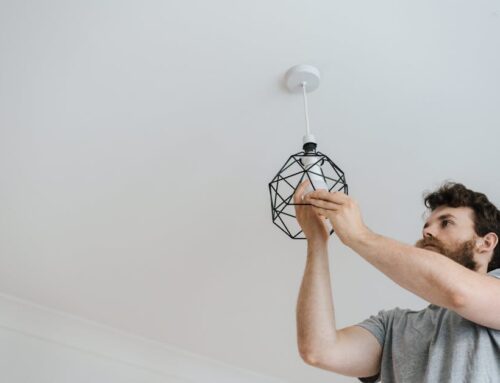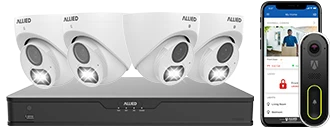- Introduction to Alarm Monitoring Services
- The Evolution of Home Security Systems
- Key Components of Modern Alarm Monitoring Services
- Benefits of Alarm Monitoring for Homeowners
- Common Technologies Used in Alarm Monitoring
- Case Studies and Real-World Examples
- Market Trends and Future Directions
- Conclusion and Final Thoughts
Introduction to Alarm Monitoring Services
Alarm monitoring services are a crucial component of modern home security systems, offering continuous surveillance and prompt responses to various emergencies such as break-ins, fires, and medical situations. Essentially, these services act as a safety net, ensuring that your home and loved ones are protected around the clock.
Allied, an award-winning home security installation and alarm monitoring company based in Texas, stands out in this domain. With nearly three decades of experience, Allied provides an impressive array of options for both residential and commercial security solutions. Whether you’re looking to protect your home or business, Allied has you covered with comprehensive packages that include police, medical, and fire alarm monitoring.
One of the standout features of Allied is their smart home security systems and surveillance systems, which not only offer unparalleled protection but also incorporate advanced automation. This means you can manage your security system remotely, control various aspects of your home environment, and receive real-time alerts directly to your smartphone. With locations in Houston, Dallas/Fort Worth, San Antonio, and Austin, Allied makes high-quality security accessible to Texans across the state.
In addition to their extensive experience and variety of security solutions, Allied is also known for its commitment to customer service. They offer a price match guarantee, ensuring that you get the best value for your investment. Furthermore, monthly monitoring services start at an affordable $19.95 per month, and they even offer free same-day setup, allowing you to enhance your home security without delay.
In sum, alarm monitoring services by Allied provide a robust and reliable means to safeguard your home and business, ensuring help is always just a call away in case of an emergency.
The Evolution of Home Security Systems
The history of home security systems spans several decades, showcasing considerable advancements in technology and service offerings. Initially, home security systems were rudimentary, relying on basic mechanisms such as locks and simple alarm systems. However, the evolution over the years has seen a significant transformation in both capabilities and sophistication.
Early Security Systems
Early home security systems were limited to mechanical locks and manual surveillance. These systems provided minimal protection and were highly dependent on the physical presence of individuals to monitor and respond to incidents.
First-Generation Electronic Systems
The development of electronic security systems marked the first significant leap in home security. Introduced in the mid-20th century, these systems utilized electrical circuits to detect unauthorized entry. When a door or window was opened, the circuit was broken, triggering an audible alarm. This innovation provided a deterrent effect and alerted homeowners and neighbors to potential break-ins.
Introduction of Monitoring Services
By the 1970s and 1980s, home security systems had begun to incorporate remote monitoring capabilities. This development allowed alarms to be connected to a central monitoring station via telephone lines. In the event of an alarm, the monitoring station could quickly notify local law enforcement or emergency services, significantly enhancing the response time and effectiveness of security measures.
Modern Smart Security Systems
The advent of the internet and advancements in wireless technology have revolutionized home security systems. Modern smart home security systems integrate a variety of technologies and offer features such as remote access, real-time alerts, and integration with other smart home devices. These systems use a combination of sensors, cameras, and smart locks, all connected to a central hub that can communicate with a user’s smartphone or other devices.
Key Technological Milestones
| Year | Development |
|---|---|
| 1940s | Introduction of simple burglar alarms using electrical circuits |
| 1970s | Connection of alarms to central monitoring stations via telephone lines |
| 2000s | Integration of internet and wireless technologies in home security systems |
| 2010s | Development of smart home security systems with remote access and real-time alerts |
Current Trends and Future Directions
Today, the focus is on enhancing the interoperability of home security systems with other smart home devices, ensuring seamless user experiences. The increasing use of artificial intelligence and machine learning also promises more robust and proactive security measures. Future developments are likely to include even more integrated and sophisticated systems that anticipate potential threats before they materialize, offering homeowners greater peace of mind and security.
Key Components of Modern Alarm Monitoring Services
Modern alarm monitoring services comprise several key components essential for ensuring comprehensive home security. These components work together to detect, report, and respond to potential security breaches and other emergencies.
1. Control Panel
The control panel is the central hub of an alarm monitoring system. It communicates with all connected devices and sends alerts to the monitoring center. Modern control panels often feature touchscreens for user-friendly operation and provide real-time system status updates.
2. Sensors
Sensors are critical in detecting unauthorized entry or environmental hazards. The most common types of sensors include:
- Door and window sensors: Trigger alarms when a door or window is opened forcefully or unexpectedly.
- Motion detectors: Detect movement within a specified range and are usually placed in high-traffic areas.
- Glass break sensors: Identify the sound frequency of breaking glass and activate alarms accordingly.
- Environmental sensors: Monitor for smoke, carbon monoxide, or water leaks, providing alerts for these specific threats.
3. Communication Devices
Communication devices ensure that the control panel can relay alerts to the monitoring center. These can include:
- Cellular communicators: Use mobile networks to transmit alerts, offering a reliable alternative to landline connections.
- Wi-Fi communicators: Utilize home internet connections to send data to the monitoring center.
- Landline connections: Traditional method using telephone lines to communicate with the monitoring center.
4. Surveillance Cameras
Surveillance cameras enhance monitoring by providing live and recorded video footage. Key features often include:
- High-definition (HD) video
- Night vision
- Motion-activated recording
- Remote access via smartphone apps
5. Alarm Sirens
Alarm sirens are installed both inside and outside the home to deter intruders and alert neighbors. These sirens emit loud, unmistakable sounds that draw attention to the property during a security breach.
Table: Common Components and Their Functions
| Component | Function |
|---|---|
| Control Panel | Central hub for managing all connected devices and sending alerts |
| Door/Window Sensors | Detect unauthorized opening of doors and windows |
| Motion Detectors | Identify movement in monitored areas |
| Glass Break Sensors | Respond to the sound of breaking glass |
| Environmental Sensors | Monitor for smoke, carbon monoxide, and water leaks |
| Surveillance Cameras | Provide visual monitoring and recording |
| Alarm Sirens | Emit loud sounds to deter intruders and alert neighbors |
These key components collectively contribute to the effectiveness of modern alarm monitoring services, ensuring that homeowners receive timely alerts and can take appropriate action to safeguard their property.
Benefits of Alarm Monitoring for Homeowners
Alarm monitoring services offer numerous benefits for homeowners, providing advanced security measures that go beyond traditional alarm systems. One of the primary advantages is the 24/7 surveillance that ensures your home is continuously monitored for any signs of intrusion, fire, or other emergencies, even when you are not present. This constant vigilance can significantly reduce response times in the event of an incident.
Moreover, alarm monitoring services are often integrated with modern smart home technologies. This integration allows homeowners to control and monitor their security systems remotely using smartphones or other devices. Features such as real-time alerts and remote arming and disarming of the system provide added convenience and peace of mind.
Another significant benefit is the professional response that alarm monitoring services offer. In the event of an alarm trigger, the monitoring center can quickly assess the situation and, if necessary, dispatch emergency services to your home. This rapid intervention can be crucial in mitigating potential damages or losses.
Insurance companies frequently recognize the value of alarm monitoring services, often offering discounts on homeowner’s insurance premiums. This is because professionally monitored alarm systems can decrease the likelihood of severe incidents, making the home a lower risk for insurers.
Additionally, alarm monitoring services can enhance the overall security of the neighborhood. Homes with visible alarm systems and monitoring service signs can deter potential criminals, contributing to a safer community environment for everyone.
Finally, another important benefit is the peace of mind it provides homeowners. Knowing that your home is protected around the clock allows you to focus on other aspects of life, confident that any emergencies will be promptly addressed by professionals.
Common Technologies Used in Alarm Monitoring
Alarm monitoring services employ a variety of technologies to ensure that your home is continuously protected against potential threats. These technologies are designed to detect, notify, and sometimes even prevent unauthorized access or emergencies. Among the most common technologies used in alarm monitoring are sensors, communication protocols, and surveillance tools.
1. Sensors
Sensors are crucial in detecting unusual activities or conditions inside and around the home. The primary types include:
- Motion Sensors: Detect movement within a designated area. They use technologies like infrared, ultrasonic, or microwave to sense any activity.
- Door and Window Sensors: Trigger an alert when a door or window is opened unexpectedly. These often use magnetic sensors to detect separation.
- Glass Break Detectors: Identify the sound frequency of breaking glass and trigger an alarm.
- Environmental Sensors: Monitor various environmental conditions such as smoke, carbon monoxide, flooding, and temperature changes to alert homeowners of potential hazards.
2. Communication Protocols
Effective alarm monitoring relies on robust communication methods to send alerts from the sensors to the monitoring centers and homeowners. Common protocols include:
- Telephone Line: Traditional landlines are still used by some systems for transmitting alerts.
- Cellular Networks: More advanced systems utilize cellular networks to ensure constant communication, even if phone lines are cut.
- Internet/Broadband: Using the home’s internet connection for faster and more reliable communication. This also allows for remote monitoring via smartphones or computers.
- Radio Frequency: Employed in some systems for local area communication between sensors and the central control panel.
3. Surveillance Tools
Surveillance cameras play a vital role in modern alarm monitoring, offering visual confirmation of an incident. Key surveillance technologies include:
- IP Cameras: Internet Protocol cameras transmit video footage over the internet, enabling remote viewing from any location.
- HD Cameras: High-definition cameras provide clearer and more detailed images, which can be crucial for identifying intruders or analyzing incidents.
- PTZ Cameras: Pan-tilt-zoom cameras offer the ability to rotate, tilt, and zoom in on specific areas, providing flexible monitoring capabilities.
- Night Vision Cameras: Equipped with infrared technology to capture video in low-light or no-light conditions.
Each of these technologies plays a critical role in creating a comprehensive and reliable alarm monitoring system, ensuring that homeowners can maintain a high level of security and peace of mind.
Case Studies and Real-World Examples
Case studies and real-world examples can provide a concrete understanding of how alarm monitoring services have effectively prevented crimes and mitigated risks in diverse residential settings. By examining these instances, homeowners can grasp the practical benefits and limitations of employing such systems.
Real-World Examples
An analysis of records from various law enforcement agencies reveals a significant reduction in burglary rates in homes with alarm monitoring systems. For instance, a study conducted by the Rutgers University School of Criminal Justice found that residential neighborhoods with a higher density of alarm systems experienced notably lower crime rates, even among homes without security systems. The presence of these systems deters potential intruders, creating a collective shield of protection.
Impact on Crime Prevention
According to data from the National Council for Home Safety and Security, homes without alarm systems are nearly three times more likely to be targeted by burglars than those with surveillance. This statistic exemplifies the substantial deterrent effect that alarm monitoring services can have.
- In a survey conducted by the Electronic Security Association (ESA), 60% of convicted burglars indicated that the presence of an alarm would cause them to seek an alternative target.
- The FBI’s Uniform Crime Reporting (UCR) Program consistently reports lower instances of property crimes in areas with higher penetration of monitored alarm systems.
| Study/Organization | Key Findings |
|---|---|
| Rutgers University | Lower crime rates in neighborhoods with higher alarm system density. |
| National Council for Home Safety and Security | Homes without alarms are nearly three times more likely to be targeted. |
| Electronic Security Association | 60% of burglars would avoid homes with alarm systems. |
| FBI UCR Program | Reduced property crimes in areas with prevalent alarm monitoring. |
Effectiveness in Emergency Situations
Alarm monitoring systems have also proven effective in non-criminal emergencies. For example, many modern systems include smoke, carbon monoxide, and flood monitoring capabilities. The U.S. Fire Administration states that homes with monitored smoke detection systems are likely to experience less damage during a fire incident due to prompt emergency response.
Overall, the real-world application of alarm monitoring services underscores their role in enhancing home security and safety, significantly reducing the likelihood of burglary and expediting assistance during emergencies.
Market Trends and Future Directions
Alarm monitoring services have evolved significantly and are now an integral part of the home security market. According to a report by MarketsandMarkets, the home security systems market is projected to grow from USD 53.6 billion in 2020 to USD 78.9 billion by 2025, at a CAGR of 8.0%. This growth reflects increasing adoption rates and technological advancements.
Several key trends are driving this uptick in the market. One notable trend is the integration of artificial intelligence (AI) and machine learning. These technologies are enhancing the capabilities of alarm monitoring systems, allowing for more accurate threat detection and reducing the incidence of false alarms. For example, AI can differentiate between common household movements and potential intrusions, leading to a more efficient security mechanism.
The Internet of Things (IoT) is also playing a crucial role. Smart home devices can now communicate with alarm systems, providing real-time updates and allowing homeowners to monitor their properties remotely. This connectivity is bolstered by the increasing proliferation of high-speed internet and advancements in wireless technology.
Another significant trend is the shift towards professional monitoring services. While self-monitoring options are available and appealing to budget-conscious consumers, professionally monitored systems offer a higher level of security and peace of mind. According to a survey by the Security Industry Association, 63% of consumers with professionally monitored systems feel safer compared to 47% of those using self-monitored solutions.
Moreover, the market is seeing an increase in subscription-based models, making high-end security solutions more accessible to a wider audience. Monthly subscription plans allow consumers to spread out the cost while gaining access to premium features such as 24/7 professional monitoring, emergency response services, and smart home integration.
In terms of future directions, the market is likely to witness further advancements in biometric security and enhanced user authentication methods. Gartner predicts that by 2024, 30% of organizations and homes will be using biometric authentication for access control, up from less than 5% today. This shift is driven primarily by the need for more secure and fool-proof methods of securing homes.
Another anticipated development is the increased use of predictive analytics. By analyzing patterns and learning from past incidents, these systems can predict potential security breaches before they occur, thereby providing proactive protection.
In conclusion, the market for alarm monitoring services is dynamic and continues to evolve rapidly. Current trends such as AI, IoT, professional monitoring, and subscription models are shaping the industry. Future advancements in biometric authentication and predictive analytics are expected to further enhance the effectiveness and appeal of alarm monitoring systems, offering even greater security for homeowners.
Conclusion and Final Thoughts
In conclusion, the importance of alarm monitoring services for your home cannot be overstated. They play a critical role in enhancing the safety and security of your property and loved ones. By providing real-time monitoring and immediate response to potential threats, these services significantly reduce the risks associated with burglaries, fires, and other emergencies.
Data from various studies support the effectiveness of alarm monitoring services. According to the FBI’s Uniform Crime Reporting program, homes without alarm systems are approximately 300% more likely to be broken into, highlighting the deterrent effect of monitored alarms. Additionally, the National Fire Protection Association (NFPA) reports that homes with monitored smoke detection systems have significantly lower incidences of fire-related injuries and fatalities, underscoring the importance of these systems in protecting lives.
Moreover, insurance companies often recognize the value of alarm monitoring services. Many providers offer discounts on homeowners’ insurance premiums for properties equipped with comprehensive alarm systems. This offers an added financial incentive for homeowners to invest in such services, providing both peace of mind and economic benefits.
As technology continues to evolve, alarm monitoring services are becoming increasingly sophisticated, incorporating innovations such as smart home integration, mobile app control, and advanced analytics. These advancements further enhance the effectiveness and convenience of alarm monitoring, making it an integral part of modern home security strategies.
Ultimately, the decision to invest in alarm monitoring services is a proactive step towards safeguarding your home. By leveraging professional monitoring and the latest technologies, homeowners can create a secure environment that not only protects their assets but also ensures the well-being of their family members.













